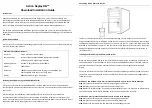
2-11
Rev 2.2, 10/31/94
2.11 Modulated Delay
Yet another wrinkle on delay is modulating the delay time. This causes the delay time to vary
according to the frequency and amplitude of the modulating signal. If you choose a short delay
time (typically around 1 ms), a low modulation frequency, and roughly a 50-50 mix of direct
signal and delayed signal, you'll get flanging. Adding feedback accentuates the effect.
If you alter the mix to favor the delayed signal and raise the modulation frequency, you'll get
pitch bending, vibrato, or chorusing.
2.12 MIDI
If you aren't aware of MIDI, well... Several years ago, a number of musical synthesizer
manufacturers somehow agreed on a serial data protocol to exchange control information
between synthesizers. They called the result MIDI: Musical Instrument Digital Interface. The
success of this standard is phenomenal (not that it is perfect) and the ability to control
something via MIDI has been applied to everything from synthesizers to signal processors to
lighting systems.
Nearly every parameter of the 601 may be controlled or modified via MIDI. The 601's MIDI
implementation is described in Appendix C.
What does this mean for the 601? At a very basic level, it means that you could have several
setups stored in the 601 and change between them remotely. If you're a broadcaster, you could
have a MIDI controller output program change commands based on a clock, which would
change the settings of the on-air 601 to the personalized settings for each of your on-air
personalities. If you're a musician, it means that the settings of the 601 can be changed from
note to note, measure to measure, during the solo, between songs, ...get the picture? The 601's
MIDI capability can also be used for dynamic parameter control (realtime control via MIDI
continuous controller) and parameter editing (making parameter changes via MIDI). Both of
these activities require an external MIDI controller or a MIDI-equipped computer.
2.13 Program Memory
The 601 has 256 memory locations for program storage. The first 128 locations are reserved for
user memory; the last 128 locations are reserved for the factory supplied programs. You may
recall any factory program (or any other stored program), edit it (modify any of its parameters),
and store the result into one of the user memory locations. Later, these programs may be
recalled via the front panel, or via MIDI for reuse or further editing.
Summary of Contents for 601
Page 46: ...4 18 Rev 2 2 10 31 94 This page is blank believe it or not ...
Page 48: ...4 20 Rev 2 2 10 31 94 Notes ...
Page 50: ...5 2 Rev 2 2 10 31 94 Notes ...
Page 70: ...7 16 Rev 2 2 10 31 94 Notes ...
Page 72: ...8 2 Rev 2 2 10 31 94 Notes ...
Page 74: ...9 2 Rev 2 2 10 31 94 Notes ...
Page 78: ...11 2 Rev 2 2 10 31 94 Notes ...
Page 126: ...D 12 Rev 2 2 10 31 94 Notes ...
Page 138: ...G 8 Rev 2 2 10 31 94 Notes ...
















































